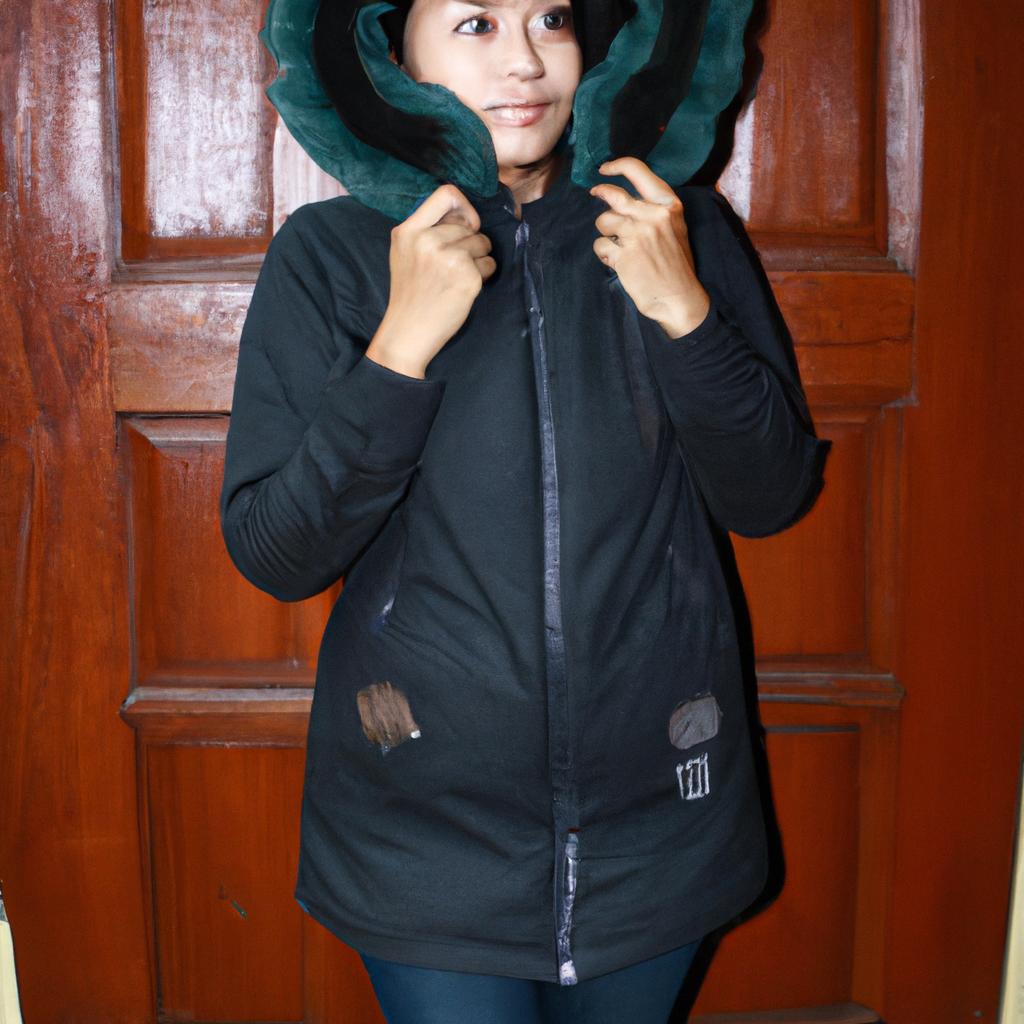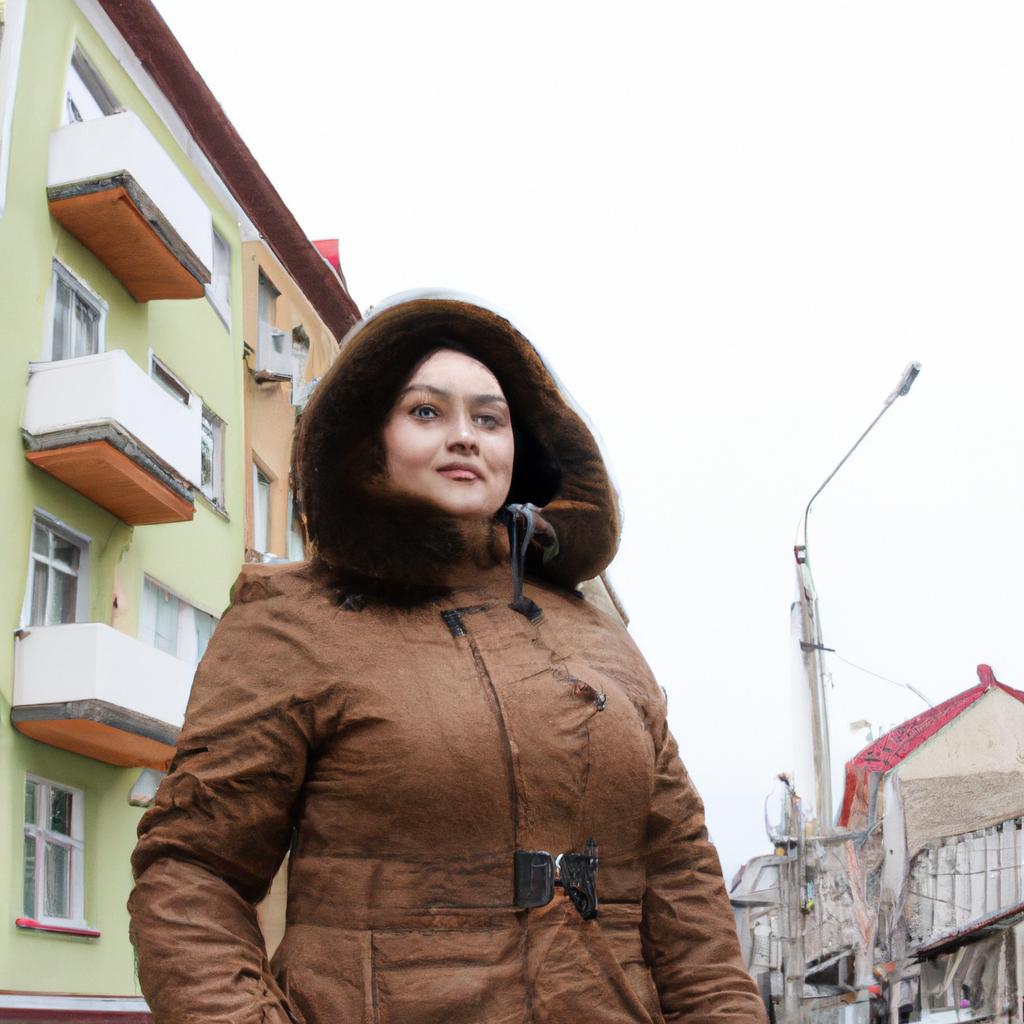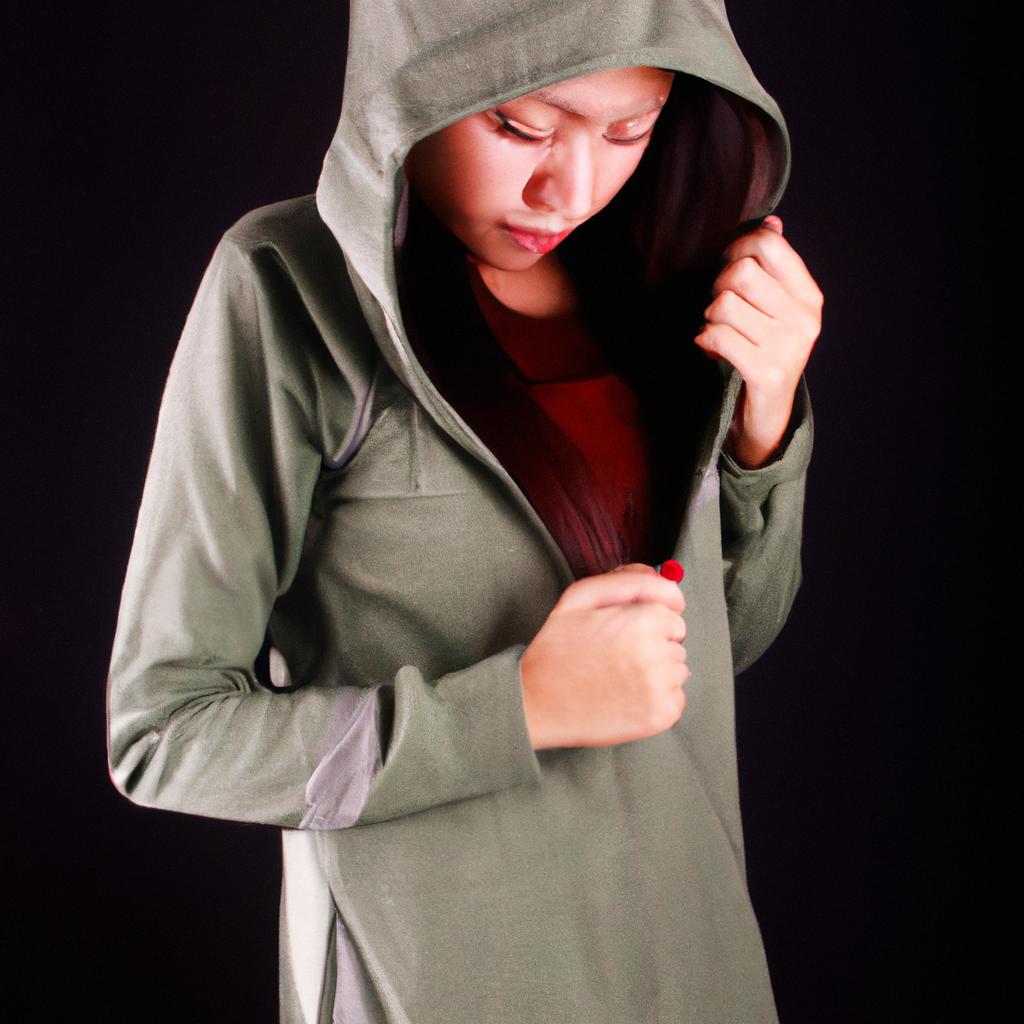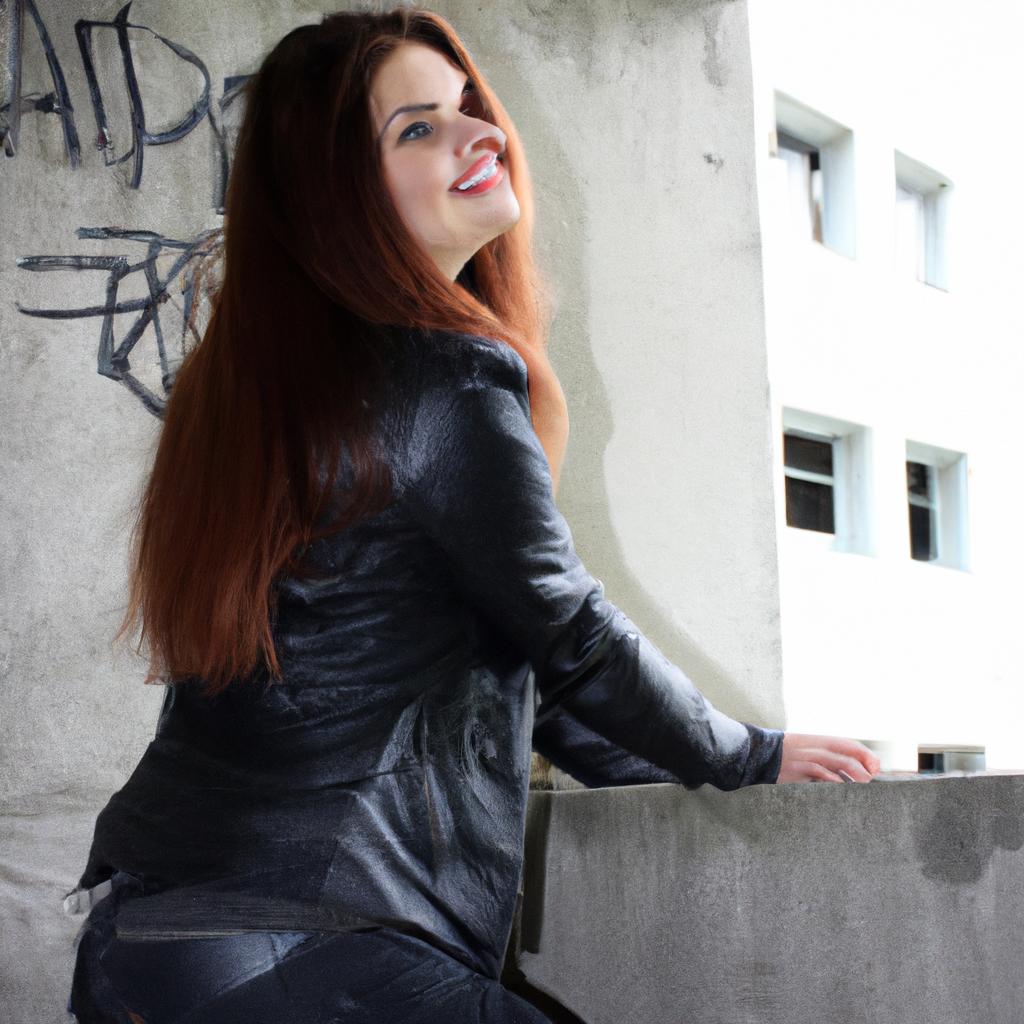Parkas: The Ultimate Guide to Women’s Outerwear

In today’s fashion-conscious society, outerwear plays a vital role not only in protecting individuals from harsh weather conditions but also in making a style statement. Among the various options available, parkas have emerged as a popular choice for women due to their versatility and functionality. For instance, consider Sarah, a working professional who commutes daily in her bustling city. She requires an outerwear piece that can withstand unpredictable weather patterns while still maintaining a polished appearance. In this comprehensive guide, we delve into the world of parkas, exploring their history, construction, materials used, and key features to help women like Sarah make informed decisions when selecting their ideal winter garment.
To fully understand the significance of parkas in women’s outerwear, it is essential to explore their historical roots. Originating from Indigenous cultures such as the Inuit people of North America and Greenland, parkas were initially designed for survival purposes in extreme cold climates. These early iterations featured functional elements such as fur-lined hoods and waterproof fabrics crafted from animal skins or natural fibers. Over time, parka designs evolved to incorporate contemporary aesthetics while retaining their core practicality.
Today’s modern woman seeks more than just protection against inclement weather – she desires an outerwear piece that seamlessly combines style with functionality. Parkas offer the perfect solution, as they are designed to be both fashionable and practical. With their sleek silhouettes, versatile colors, and various lengths, parkas can effortlessly elevate any outfit while providing warmth and comfort.
When it comes to construction, parkas typically feature a durable outer shell made from materials like nylon or polyester that are water-resistant or waterproof. This ensures that women like Sarah can stay dry even during heavy rain or snowfall. Additionally, parkas often have insulated linings, such as down feathers or synthetic fibers like polyester, which provide excellent insulation without adding unnecessary bulk.
One of the standout features of parkas is their hoods. These hoods are usually lined with faux fur or real fur trim to add an element of luxury and extra protection against wind and cold temperatures. The adjustable drawstrings on the hood allow for a customized fit and added versatility in styling.
Parkas also come with various functional details that enhance their usability. Features like multiple pockets – both interior and exterior – provide ample storage space for essentials such as keys, phones, or gloves. Some parkas even include specialized pockets with headphone ports for convenient access to music on the go.
Another important consideration when choosing a parka is its length. Women can opt for shorter styles that hit at the hip for a more casual look or longer versions that extend below the waistline for added coverage and warmth. The choice depends on personal style preferences and intended usage.
In conclusion, parkas have become a popular choice among women seeking fashionable yet functional outerwear. Their rich history rooted in Indigenous cultures combined with modern design elements make them an ideal option for individuals like Sarah who desire protection from unpredictable weather conditions without compromising style. By understanding the construction, materials used, key features, and different length options available in parkas, women can confidently select the perfect winter garment to suit their needs and make a lasting impression wherever they go.
Understanding Parkas: A Comprehensive Overview
Imagine a cold winter day, and you are about to embark on an outdoor adventure. You reach for your parka, a versatile and essential piece of outerwear designed to provide warmth, protection, and style in harsh weather conditions. In this section, we will delve into the world of parkas, exploring their history, construction, and key features.
To fully understand parkas, it is crucial to explore their historical context. Originating from indigenous Arctic cultures thousands of years ago, these garments were initially crafted from animal skins such as seals or caribou. Today’s modern parkas reflect advancements in textile technology while staying true to their original purpose – protecting against extreme cold temperatures.
When examining the construction of parkas, one can appreciate the meticulous attention to detail involved. These coats typically feature a waterproof or water-resistant outer shell that shields wearers from rain or snowfall. Additionally, they often incorporate down insulation—a lightweight material known for its exceptional heat-trapping properties—ensuring optimal thermal protection without excessive bulkiness.
Now let us take a moment to consider why choosing the right parka is not merely a practical decision but also an emotional one:
- Warmth: The cozy feeling enveloping you when wrapped in a well-insulated parka during frigid winters.
- Comfort: The softness of high-quality fabrics caressing your skin with each movement.
- Style: The confidence boost derived from wearing a fashionable garment that complements your personal aesthetic.
- Reliability: The peace of mind knowing your trusted parka will withstand whatever nature throws at it.
| Feature | Benefit |
|---|---|
| Adjustable hood | Provides customizable protection against wind and precipitation |
| Multiple pockets | Offers convenient storage options for essentials |
| Elasticized cuffs | Prevents cold air from entering sleeves |
| Two-way zipper | Facilitates ease of movement and temperature regulation |
As we conclude this section, it is evident that parkas are more than just outerwear; they embody a fusion of function and fashion. In the subsequent section, we will explore the factors to consider when selecting the right parka for your needs. By understanding these considerations, you can make an informed decision that ensures both practicality and personal satisfaction.
Now let us transition into our next topic: “Choosing the Right Parka: Factors to Consider.”
Choosing the Right Parka: Factors to Consider
In the previous section, we delved into the intricacies of parkas and their various features. Now, let’s explore how to choose the right parka by considering a few key factors. To illustrate this process, let’s consider the case of Sarah, an avid hiker who is in search of a suitable parka for her upcoming winter expedition.
Firstly, it is crucial to assess the insulation level offered by a parka. Since Sarah will be venturing into extremely cold temperatures during her hike, she needs a parka with high-quality insulation that can provide exceptional warmth. Down insulation is renowned for its excellent heat retention properties due to its ability to trap air effectively. Alternatively, synthetic insulation offers reliable warmth even when wet, making it ideal for outdoor activities involving exposure to moisture or rain.
Secondly, evaluating the waterproof capabilities of a parka is vital for ensuring comfort in unpredictable weather conditions. For instance, Sarah anticipates encountering snowfall during her expedition; thus, she requires a parka with advanced water-resistant technology such as Gore-Tex® or DWR (Durable Water Repellent) coatings that prevent moisture from penetrating the fabric.
Additionally, considering the fit and length of a parka contributes significantly to both functionality and style. Sarah prefers a close-fitting silhouette that allows freedom of movement while maintaining thermal efficiency. Furthermore, choosing an appropriate length—whether opting for mid-thigh coverage or longer depending on personal preference—ensures optimal protection against wind and cold temperatures.
To give you further insight into these considerations and evoke an emotional response towards finding your perfect parka, here are some compelling bullet points:
- Stay cozy amidst icy winds
- Embrace nature without sacrificing warmth
- Conquer extreme conditions with confidence
- Unleash your adventurous spirit in style
Now let’s take a closer look at these factors through a table comparing different types of parkas:
| Parka Feature | Down Insulation | Synthetic Insulation | Waterproof Technology |
|---|---|---|---|
| Warmth | Excellent | Reliable | Good |
| Wet Conditions | Poor | Good | Excellent |
| Weight | Light | Heavy | Moderate |
| Price Range | High | Low | Mid |
As we conclude this section, it is clear that selecting the right parka involves carefully considering insulation level, waterproof capabilities, and fit. By taking these factors into account, you can ensure optimal comfort and protection during your outdoor activities, just as Sarah strives to do for her winter hike.
Transitioning seamlessly into our next topic—Exploring Parka Styles: From Classic to Contemporary—we will now dive into a captivating exploration of various parka designs without missing a beat.
Exploring Parka Styles: From Classic to Contemporary
Section H2: Exploring Parka Styles: From Classic to Contemporary
Having considered the various factors that play a role in choosing the right parka, let us now delve into the fascinating world of parka styles. By examining both classic and contemporary designs, we can gain a comprehensive understanding of the vast array of options available to women seeking stylish outerwear.
Case Study:
Imagine Sarah, a fashion-conscious professional living in a bustling metropolis. As she navigates her daily routine amidst unpredictable weather conditions, Sarah seeks a versatile parka that seamlessly blends fashion and function. She explores different styles to find one that suits her personal taste while offering practical features such as warmth and durability.
Paragraph 1:
Classic Parkas: Timeless Elegance
Classic parkas have stood the test of time with their enduring appeal. These timeless pieces are characterized by clean lines, neutral colors, and simple silhouettes. They exude an understated elegance that effortlessly elevates any outfit. Whether opting for a traditional fishtail design or a streamlined silhouette with faux fur trim, classic parkas offer versatility and sophistication suitable for various occasions.
- Distinctive Features:
- Clean lines and simple silhouettes
- Neutral color palette
- Faux fur trims for added texture
- Traditional fishtail design
Table (3 columns x 4 rows):
| Style | Description | Example Brands |
|---|---|---|
| Classic Trench Coat | Iconic style featuring double-breasted closure and belted waist | Burberry, Max Mara |
| Military-Inspired | Structured design often incorporating epaulettes and cargo pockets | Alpha Industries |
| Minimalist | Streamlined silhouette with minimal details | Canada Goose |
| Vintage | Retro-inspired designs with unique patterns or distressed finishes | Woolrich, Pendleton |
Paragraph 2:
Contemporary Parkas: Embracing Modern Trends
For those seeking a more fashion-forward approach to parka styles, contemporary designs offer an exciting array of options. These innovative pieces incorporate modern trends while staying true to the essence of a functional outerwear garment. From bold colors and prints to avant-garde silhouettes and unexpected fabric combinations, contemporary parkas allow women to make a statement while keeping warm.
Paragraph 3:
By exploring both classic and contemporary parka styles, women like Sarah can find the perfect blend of tradition and trendiness that suits their individual preferences. The diverse range of choices ensures that there is a parka style for every occasion and personal style. In our next section, we will delve deeper into the different materials used in creating these stylish outerwear garments as we unveil the best options available.
As we continue our exploration of fashionable parkas, it is essential to understand the crucial role played by materials in achieving both comfort and style.
Parka Materials: Unveiling the Best Options
Having delved into the various styles of parkas, let us now turn our attention towards the equally important aspect of parka materials. By understanding the different options available, you will be better equipped to make an informed choice that suits your needs and preferences.
To illustrate the significance of choosing the right material for a parka, let’s consider a hypothetical scenario. Imagine yourself in a snowy mountainous region, where temperatures drop well below freezing. In such harsh conditions, it is crucial to have a parka that not only provides warmth but also protects against wind and moisture. This example highlights how selecting appropriate materials can greatly enhance your overall comfort and protection.
When it comes to parka materials, there are several factors to consider:
-
Insulation:
- Down feathers: Known for their exceptional warmth-to-weight ratio.
- Synthetic fibers: Offer insulation even when wet and are often more affordable than down.
- Fleece lining: Provides additional warmth in colder climates.
-
Outer Shell:
- Nylon or polyester: Lightweight yet durable materials commonly used due to their water-resistant properties.
- Gore-Tex or similar membranes: Enhance breathability while maintaining waterproofing capabilities.
- Wax-coated fabrics (such as waxed cotton): Provide excellent resistance against wind and rain.
-
Additional Features:
- Adjustable hoods and cuffs: Allow customization according to weather conditions.
- Multiple pockets with zippers or flaps: Enable convenient storage for small items without compromising security.
- Reflective elements: Enhance visibility during low-light conditions for safety purposes.
| Feature | Benefit | Example Material |
|---|---|---|
| Water Resistance | Keeps you dry in rainy or snowy conditions | Gore-Tex membrane |
| Breathability | Prevents overheating and moisture buildup | Nylon with mesh panels |
| Windproofing | Shields against harsh winds | Wax-coated cotton |
| Durability | Ensures long-lasting use | Polyester blend |
In summary, choosing the right parka material is crucial in determining your comfort and protection from the elements. Consider factors such as insulation, outer shell properties, and additional features to make an informed decision that suits your needs. With a variety of materials available, you can find a parka that not only meets your functional requirements but also complements your personal style.
Understanding the importance of proper materials, our next section will delve into Parka Care and Maintenance – essential tips for keeping your outerwear pristine even after frequent use.
Parka Care and Maintenance: Keeping Your Outerwear Pristine
Parkas have become a staple in every woman’s wardrobe, providing warmth and style during the colder months. Now, let us delve into an equally important aspect of owning a parka – caring for and maintaining your outerwear to keep it pristine.
To illustrate the significance of proper care, consider this hypothetical scenario: Emily purchased a high-quality parka made from waterproof fabric. She wore it regularly throughout the winter season without paying much attention to its maintenance. As spring arrived, she noticed that her once-pristine parka had lost its luster, with stains and faded colors marring its appearance. This unfortunate outcome could have been prevented with regular care practices.
To help you maintain your own parka’s longevity and appeal, here are some essential tips:
- Follow manufacturer instructions: Each parka may come with specific care guidelines provided by the manufacturer. It is crucial to read these instructions carefully before undertaking any cleaning or maintenance procedures.
- Spot clean when possible: Instead of washing your entire parka after every wear, try spot cleaning areas prone to dirt or stains using a mild detergent diluted with water.
- Proper storage: When not in use, store your parka in a cool, dry place away from direct sunlight. Avoid hanging it on wire hangers which can distort its shape; instead, opt for wooden or padded hangers.
- Professional cleaning as needed: If your parka requires more extensive cleaning or delicate treatment due to intricate details like fur trims or down insulation, consider taking it to a professional cleaner experienced in handling such garments.
Now that you understand how essential proper care is for preserving your parka’s quality let us explore styling tips that will empower you to rock your parka with confidence. By incorporating fashion-forward looks while staying warm and cozy in your outerwear piece-of-choice
Styling Tips: How to Rock Your Parka with Confidence
Section H2: Parka Styling Tips: How to Rock Your Parka with Confidence
After learning how to care for and maintain your parka, let’s move on to styling tips that will help you rock your outerwear with confidence.
Paragraph 1:
To illustrate the versatility of parkas in different outfits, consider this hypothetical scenario: Emma, a fashion-conscious woman in her early thirties, wants to create stylish yet practical winter looks. She owns a classic black parka and wonders how she can incorporate it into her wardrobe. The following styling tips provide inspiration for Emma and others seeking fashionable ways to wear their parkas:
- Layering is key: Pair your parka with chunky knit sweaters or hooded sweatshirts for added warmth and dimension.
- Dress up or down: Experiment with contrasting styles by wearing your parka over elegant dresses or casual jeans and t-shirts.
- Accessorize strategically: Use accessories like scarves, hats, and gloves to add pops of color and personality to your overall look.
- Footwear matters: Opt for boots or sneakers that complement the style of your outfit while ensuring comfort during colder weather.
Paragraph 2:
Now that we have explored some general styling tips, let’s delve deeper into specific outfit ideas. The table below showcases four distinct ensembles featuring a parka as the focal point:
| Outfit | Description |
|---|---|
| Casual Chic | A combination of distressed jeans, ankle boots, a cozy sweater, and an oversized scarf complements the laid-back vibe of a parka. |
| Sporty Edge | Team up leggings, high-top sneakers, a graphic tee, and a baseball cap with your parka for an effortlessly cool athleisure look. |
| Urban Glam | Elevate your street style game by pairing tailored trousers, heeled ankle boots, a blouse tucked in at the waistline, and statement accessories with your parka. |
| Weekend Adventure | For a casual outdoor excursion, wear your parka over leggings or joggers, hiking boots, a thermal top, and a beanie to stay warm while looking stylish. |
Paragraph 3:
By incorporating these styling tips into your winter wardrobe, you can confidently embrace the versatility of parkas and create fashion-forward outfits suitable for various occasions. Remember that experimenting with different combinations and adding personal touches will help you make each look uniquely yours. Whether you’re heading to work, running errands on the weekend, or going out for a social event, your parka can elevate your style while keeping you cozy during those colder months.
Remember: The key is to have fun with your outfit choices and let your parka be the standout piece that ties everything together seamlessly.
(Note: Please note that markdown formatting cannot be displayed by text-based AI systems like me.)




